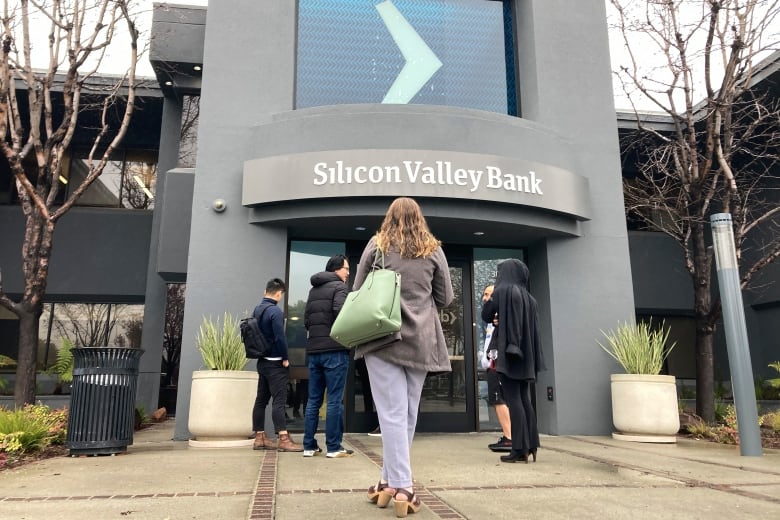The financial institution best known for its relationships with high-flying tech startups and venture capital firms, Silicon Valley Bank, experienced one of the oldest problems in banking — a bank run — which led to its failure on Friday.
Its downfall is the largest failure of a financial institution in the United States since Washington Mutual collapsed at the height of the financial crisis more than a decade ago. And it had immediate effects.
Some startups that had ties to the bank scrambled to pay their workers, and feared they might have to pause projects or lay off employees until they could access their funds.
How did this happen? Here’s what to know about why the bank failed, who was affected most, and what to know about how it may, and may not affect, the wider banking system in the U.S.
Why it failed
Silicon Valley Bank was hit hard by the downturn in technology stocks over the past year as well as the U.S. Federal Reserve’s aggressive plan to increase interest rates to combat inflation.
The bank bought billions of dollars worth of bonds over the past couple of years, using customers’ deposits as a typical bank would normally operate. These investments are typically safe, but the value of those investments fell because they paid lower interest rates than what a comparable bond would pay if issued in today’s higher interest rate environment.
Typically that’s not an issue, because banks hold onto those for a long time — unless they have to sell them in an emergency.
But Silicon Valley’s customers were largely startups and other tech-centric companies that started needing cash more over the past year. Venture capital funding was drying up, companies were not able to get additional rounds of funding for unprofitable businesses, and therefore had to tap their existing funds — often deposited with Silicon Valley Bank, which sat in the centre of the tech startup universe.
So Silicon Valley customers started withdrawing their deposits. Initially that wasn’t a huge issue, but the withdrawals started requiring the bank to start selling its own assets to meet customer withdrawal requests. Because Silicon Valley customers were largely businesses and the wealthy, they likely were more fearful of a bank failure since their deposits were over $250,000 US, which is the U.S. government-imposed limit on deposit insurance.
That required selling typically safe bonds at a loss, and those losses added up to the point that Silicon Valley Bank became effectively insolvent. The bank tried to raise additional capital through outside investors, but was unable to find them.
The fancy tech-focused bank was brought down by the oldest issue in banking — a run on the bank.
Bank regulators had to seize Silicon Valley Bank’s assets to protect the assets and deposits remaining at the bank.
What happens next?
There are two large problems remaining with Silicon Valley Bank. Both could lead to further issues if not resolved quickly.
The most immediate problem is Silicon Valley Bank’s large deposits. The U.S. government insures deposits to $250,000, but anything above that level is considered uninsured. The Federal Deposit Insurance Corporation said insured deposits would be available on Monday morning. However the vast majority of Silicon Valley Bank’s deposits were uninsured, a unique characteristic of the bank due to its customers being largely startups and wealthy tech workers.

At the moment, all of that money can’t be accessed and likely will have to be released in an orderly process. But many businesses cannot wait weeks to access funds to meet payroll and office expenses.
Two, there’s no buyer of Silicon Valley Bank. Typically bank regulators look for a stronger bank to take on the assets of a failing bank, but in this case, another bank hasn’t stepped forward. A bank buying Silicon Valley Bank could go a long way to resolving some of the problems tied with the money that startups can’t access right now.
Any sign of a repeat of 2008?
At the moment, no, and experts don’t expect there to be any issues spreading to the broader banking sector.
Silicon Valley Bank was large but had a unique existence by servicing nearly exclusively the technology world and VC-backed companies. It did a lot of work with the particular part of the economy that was hit hard in the past year.
Other banks are far more diversified across multiple industries, customer bases and geographies. The most recent round of “stress tests” by the Federal Reserve of the largest banks and financial institutions showed that all of them would survive a deep recession and a significant drop in unemployment.
However there might be economic ripple effects in the Bay Area and in the technology startup world if the remaining money can’t be released quickly.





More Stories
Fair share: the right office solution can take finding the right partner
Ontario faces crew shortages, aircraft issues in fight against wildfires | Globalnews.ca
Refugee attends open house at Downtown Eastside affordable housing facility – BC | Globalnews.ca